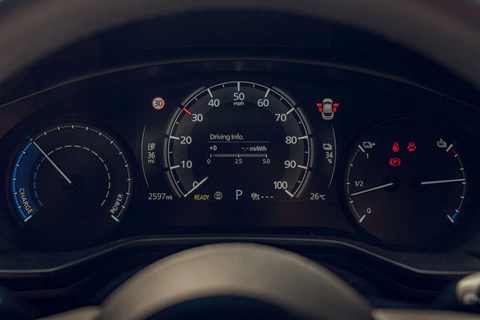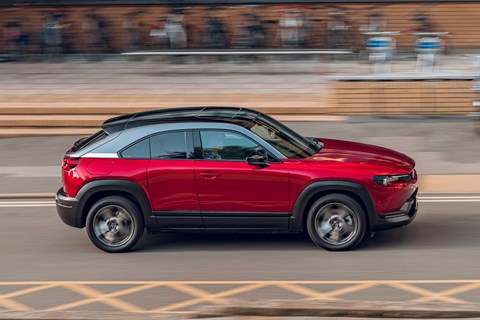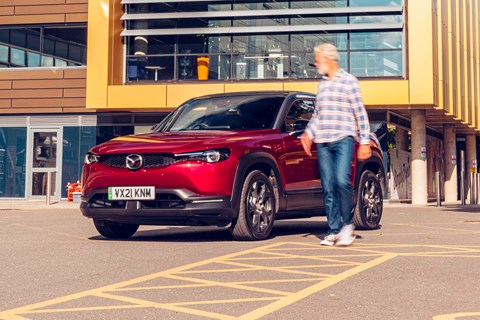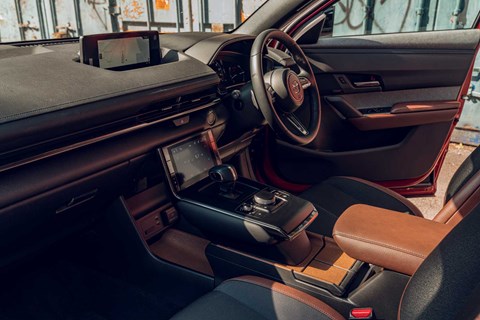► Mazda MX-30: the long-term test
► Stylish and sharp to drive
► But will Ben be put off by the tiny range?
‘Lovely car, that MX-30, but doesn’t it have a ridiculously short range?’ So many kerbside conversations have begun that way since I started driving the Mazda. Yes, its official range is a modest 124 miles, but this solitary statistic doesn’t have to define it as a vehicle. However, for many people it’s range, and range alone, that instantly categorises electric cars: below 175 miles equals bad, above 175 miles equals good.
If electricity was as readily available as petrol and diesel, then smaller urban cars like the MX-30, Fiat 500e and Honda E would sell in far greater numbers. Buyers wouldn’t be focusing on their range but rather on the qualities that make them excellent urban cars – handily sized, agile, comfortable, very comfortable two-up, capable of four-up for short trips, safe, intelligently designed and connected. Their popularity would arguably make them cheaper too.

Although the roll-out of recharging facilities across the country is approaching breakneck speed, the network is still abysmal compared to diesel and petrol. Currently (ha), electric cars either work for you or they don’t, depending on ready and reliable access to recharging facilities. And because these facilities are still relatively rare, the focus switches and sharpens to vehicle range.
We judge combustion-engined vehicles by their fitness for purpose. The same should follow for BEVs. No one buys a Skoda Fabia or Honda Jazz and then complains that it won’t do a sub-two-minute lap of Spa. No one buys a Porsche 911 Turbo or a Ferrari SF90 Stradale and then slates it for its inability to carry five adults and their luggage.
With range not being the key factor, manufacturers would have greater freedom to produce different kinds of battery-electric vehicles for different audiences, rather than being coerced into a counter-productive war around battery size. Counter-productive? Yes, because bigger batteries mean rare resources – lithium, cobalt neodymium and dysprosium – end up in fewer electric cars, reducing choice and sustainability while increasing cost.
Remove range from the buying/leasing equation and the focus would switch to cost, where BEVs are rapidly gaining ground when compared to combustion cars. And the fact is that for some people range is already not an issue, either because they only ever do modest distances, or they have access to enough charging facilities.
So my answer? ‘No, the MX-30’s range is perfectly adequate for an urban runabout.’ We’re fortunate enough to have off-street parking and an installed domestic charger. That means we charge the Mazda at home overnight, so it’s fully loaded for when we need it in the morning. And a fully-loaded 125-mile range – stretched to 155 miles if you really mooch about – is more than enough for us to use for two days of regular trips before we need to recharge. Fitness for purpose, see. If only the door seals would stop squeaking…
By Ben Whitworth
Logbook: Mazda MX-30 GT Sport Tech
Price £32,845 (£34,845 as tested, £32,345 after grant)
Performance 35.5kWh battery, 140bhp, 9.7sec 0-62mph, 87mph
Efficiency 3.5 miles per kWh (official), 3.9 miles (tested), 0g/km CO2
Range 124 miles (official), 155 miles (tested)
Energy cost 2.9p per mile
Miles this month 1514
Total miles 4951
Month 2 living with a Mazda MX-30: that old Mazda magic

Mazda’s ‘Jinbai Ittai – car and driver as one’ catchphrase probably sets your eyeballs rolling, but the MX-30 is easily the most dynamically engaging electric car I’ve driven. It really does feel like it’s been engineered by very talented people who put the driver first.
I clocked up 27,900 miles in an RX-8 back in 2008, and the similarities are uncanny: the lovely linear accelerator response, the light but pleasingly accurate steering, the fine body control, the low-slung driving position, the corner-to-corner agility – they all work seamlessly together to deliver a driving experience that easily exceeds expectations.
By Ben Whitworth
Logbook: Mazda MX-30 GT Sport Tech
Price £32,845 (£34,845 as tested, £32,345 after grant)
Performance 35.5kWh battery, 140bhp, 9.7sec 0-62mph, 87mph
Efficiency 3.5 miles per kWh (official), 3.7 miles (tested), 0g/km CO2
Range 124 miles (official), 120 miles (tested)
Energy cost 3.0p per mile
Miles this month 2448
Total miles 3437
Month 1 living with a Mazda MX-30: hello and welcome

I like Mazda a great deal. I admire and appreciate its unconventional automotive approach. It behaves like a leftfield independent car maker in an industry characterised by same-again unoriginality and bloated inertia. It is the definitive automotive underdog.
Over the last 100 years it has resolutely – often stubbornly – forged its own largely successful path. Its first vehicle, the Mazda-Go commercial trike, was launched in 1931. Three decades later it was producing the bewitching Cosmo Sport 110S, the world’s first rotary-engined production model.
It single-handedly revived the affordable roadster market with the million-seller MX-5. It was the first Japanese marque to win at Le Mans, and still the only manufacturer to do so with a non-piston powerplant (its winner was rotary-powered). More recently with Skyactiv-X, Mazda introduced the world’s first production compression-ignition petrol engine, when everyone else was downsizing and turbo-charging. And in my opinion it’s one of the few marques with a truly coherent look and feel that’s as handsome and distinctive as it is appealing and desirable. It’s consistently wrapped its obsession with advanced and lightweight engineering in the sleekest and sexiest sheet metal on our roads.
Understandably, then, Mazda has taken its next big step into electric power neither lightly nor conventionally with the MX-30. The fact that Mazda’s first production BEV is honoured with the MX moniker – saved for special occasions – illustrates the significance Mazda has attached to the MX-30. No safe and beige offering here. Instead we get a high-riding urban hatch with a coupe-like profile, RX-8-inspired rear-hinged doors, a ‘right-sized’ battery, an interior swathed in cork and the emphasis, as with all Mazdas, placed squarely on dynamism and driver engagement rather than outright range and pace. Game on.

Our GT Sport Tech, priced at £32,845, sits at the top of the UK’s MX-30 range above the SE-L Lux and Sport Lux. Standard equipment levels are embarrassingly generous, so we’ve limited our options to the stunning Soul Red Crystal Metallic paint with black roof and metallic grey side panels (£1800) to further boost the visual appeal, and the dark grey cloth with brown leatherette cabin trim (£200). That’s £34,845 all in, but £32,345 after the electric subsidy is taken in to account.
Even with that £2500 bonus, the MX-30 – like all electric cars – looks expensive next to combustion-engined alternatives. A small urban runabout with a £32,345 price tag is pretty punchy. To its credit, the Mazda wants for nothing, with standard-fit highlights including a brilliant 12-speaker Bose audio system, excellent active LED headlights, a slick and intuitive Connect infotainment platform, and a chink-free suit of active and passive safety armour.
It also looks every inch the sleek and stylish urban runabout. To my eyes Mazda’s design team has nailed it, successfully imbuing the MX-30 with a visual character that clearly distinguishes it from the existing range, while still retaining the core design principles of dynamic proportions, clean sheet metal and tidy details that make all current Mazdas style winners. Likewise the cabin: excellent driving position, tactile materials, intelligently configured controls, first-rate build quality. And odd as it sounds, that cork covering works surprisingly well, further lifting the cabin and complementing the recycled fabrics and leatherette. The next six months will tell how we’ll get on with those doors and the less than generous rear accommodation.
All models in the MX-30 line-up have front wheels driven by an e-Skyactiv single-speed water-cooled AC synchronous 105kW electric motor that develops 140bhp and 195lb ft. It’s fed by a 35.5kWh lithium-ion battery for a 0-62mph time of 9.7sec, a governed maximum speed of 87mph and a WLTP range of 124 miles. That prismatic battery weighs just 310kg, for a 1645kg kerbweight – thick-ankled by small family hatch standards, but commendably light for a BEV. A small battery means modest range, but Mazda figures the young urban and suburban families expected to favour the car will prioritise economy and agility over long range.
That deliberate decision to fit the MX-30 with a pocket-sized battery is the result of Mazda’s Life-Cycle Assessment analysis that aims to measure the total environmental impact of a product. Mazda reckons that over their entire life cycle, EVs with smaller batteries tend to produce lower CO2 emissions than comparable diesel-engined cars.
So then, an athletic and agile car with generous helpings of character, engaging performance over a very well-defined number of miles, a quirky layout and an inimitable sense of individuality. Ample compensation for a very modest range? We’ll see.
By Ben Whitworth
Logbook: Mazda MX-30 GT Sport Tech
Price £32,845 (£34,845 as tested, £32,345 after grant)
Performance 35.5kWh battery, 140bhp, 9.7sec 0-62mph, 87mph (limited)
Efficiency 3.5 miles per kWh (official), 3.7 miles per kWh (tested), 0g/km CO2
Range 124 miles (official), 120 miles (tested)
Energy cost 3.0p per mile
Miles this month 989
Total miles 989